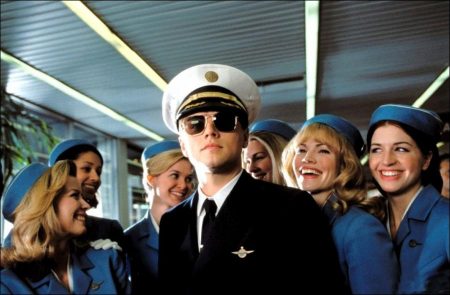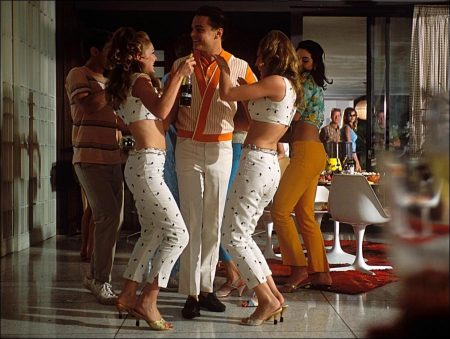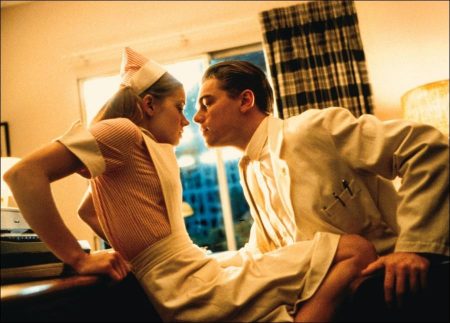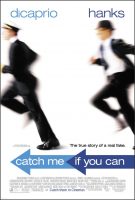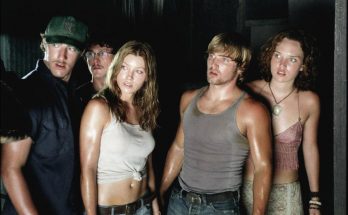Taglines: The true story of a real fake.
New Rochelle, the 1960s. High schooler Frank Abagnale Jr. idolizes his father, who’s in trouble with the IRS. When his parents separate, Frank runs away to Manhattan with $25 in his checking account, vowing to regain dad’s losses and get his parents back together.
Just a few years later, the FBI tracks him down in France; he’s extradited, tried, and jailed for passing more than $4,000,000 in bad checks. Along the way, he’s posed as a Pan Am pilot, a pediatrician, and an attorney. And, from nearly the beginning of this life of crime, he’s been pursued by a dour FBI agent, Carl Hanratty. What starts as cat and mouse becomes something akin to father and son.
Catch Me If You Can is a 2002 American biographical crime film based on the life of Frank Abagnale, who, before his 19th birthday, successfully performed cons worth millions of dollars by posing as a Pan American World Airways pilot, a Georgia doctor and a Louisiana parish prosecutor. His primary crime was check fraud; he became so experienced that the FBI eventually turned to him for help in catching other check forgers. The film was directed by Steven Spielberg and stars Leonardo DiCaprio and Tom Hanks, with Christopher Walken, Martin Sheen, and Nathalie Baye in supporting roles.
Development for the film started in 1980, but did not progress until 1997, when the film rights to Abagnale’s book were sold to Spielberg’s DreamWorks. David Fincher, Gore Verbinski, Lasse Hallström, Miloš Forman, and Cameron Crowe had all been possible candidates for director before Spielberg decided to direct. Filming took place from February to May 2002. The film was a financial and critical success, and the real Abagnale reacted positively to it.
The original start date was January 2002, but was pushed to February 7 in Los Angeles, California. Other locations included Burbank, Downey, New York City, LA/Ontario International Airport (which doubled for Miami International Airport), Quebec City and Montreal. The film was shot in 147 different locations in only 52 days. DiCaprio reflected, “Scenes that we thought would take three days took an afternoon”.
Filming ran from April 25–30 in Park Avenue, just outside the Waldorf-Astoria Hotel. Production moved to Orange, New Jersey and returned to Brooklyn for bank and courthouse scenes. Shooting also took place at the TWA Flight Center at John F. Kennedy International Airport. Quebec City was chosen for its European character and French feel. Place Royale, within Old Quebec, stands for Montrichard—the church in the background of the arrest scene is Notre-Dame-des-Victoires. Filming ended on May 12 in Montreal.
Catch Me If You Can was released on December 25, 2002, earning slightly above $30 million in 3,225 theaters during its opening weekend. The film went on to gross $164.6 million in North America and $187.5 million in foreign countries, coming at a worldwide total of $352.1 million. The film was a financial success, recouping the $52 million budget six times over. Catch Me If You Can was the eleventh highest-grossing film of 2002. Minority Report (also directed by Spielberg) was tenth highest.
Catch Me If You Can (2992)
Directed by: Steven Spielberg
Starring: Leonardo DiCaprio, Tom Hanks, Jennifer Garner, Martin Sheen, Christopher Walken, Amy Adams, Nathalie Baye, James Brolin, Nancy Lenehan, Elizabeth Banks
Screenplay by: Stan Redding, Jeff Nathanson
Production Design by: Jeannine Claudia Oppewall
Cinematography by: Janusz Kaminski
Film Editing by: Michael Kahn
Costume Design by: Mary Zophres
Set Decoration by: Elaine O’Donnell, Leslie A. Pope
Art Direction by: Sarah Knowles, Michele Laliberte
Makeup Department: Sian Grigg
Music by: John Williams
MPAA Rating: PG-13 for some sexual content and brief language.
Distributed by: DreamWorks Pictures
Release Date: December 25, 2002
Visits: 244
